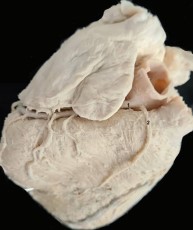Morphological analysis and clinical significance of the opening of the third coronary artery
DOI:
https://doi.org/10.17532/jhsci.2022.1889Keywords:
Anatomical variations, supernumerary arteries, third coronary arteryAbstract
Introduction: The human heart is in most cases vascularized by two coronary arteries, the right coronary artery (RCA) and the left coronary artery. The supernumerary coronary artery, which arises independently from the right aortic sinus and passes through sub-epicardial adipose tissue of the pulmonary conus and anterior side of the right ventricle is called the third coronary artery (TCA).
Methods: This study consisted of 28 formalin-fixed adult human cadaveric hearts. The presence of the TCA was determined. The position of the orifice of the right and excess arteries in relation to the sinotubular junction was determined, and then also the position of the orifice of the excess arteries “on the o’clock level” in relation to the orifice of the RCA. The radius of these orifices and their distance from the orifice of the RCA were measured. The angle between the aorta and TCA, as well as RCA and conus branch, was measured.
Results: A total 11 of specimens had supernumerary arteries. A supernumerary artery was found in two hearts. The angle formed by the aorta with the TCA was 60.09 ± 17.57, while the angle between the aorta and the conus branch had an average value of 89.88 ± 15.92. The orifices of all supernumerary arteries were located below the level of the sinotubular junction. The average diameter of the TCA was 1.49 mm ± 0.41. The average distance between the TCA orifice and the RCA orifice was 2.21 mm ± 1.03. In 45.45% cases, the orifice of TCA was located at the 10 o’clock level.
Conclusion: The present study highlights the presence of the TCA. It may constitute a significant collateral circulation contributing to apical and septal perfusion. Interpretation of signs and symptoms of coronary occlusion should therefore include possible contribution of this vascular channel.
Downloads

Downloads
Published
License
Copyright (c) 2022 Almira Lujinović, Lejla Dervišević, Esad Ćosović, Zurifa Ajanović, Dina Kapić, Esad Pepić

This work is licensed under a Creative Commons Attribution 4.0 International License.










